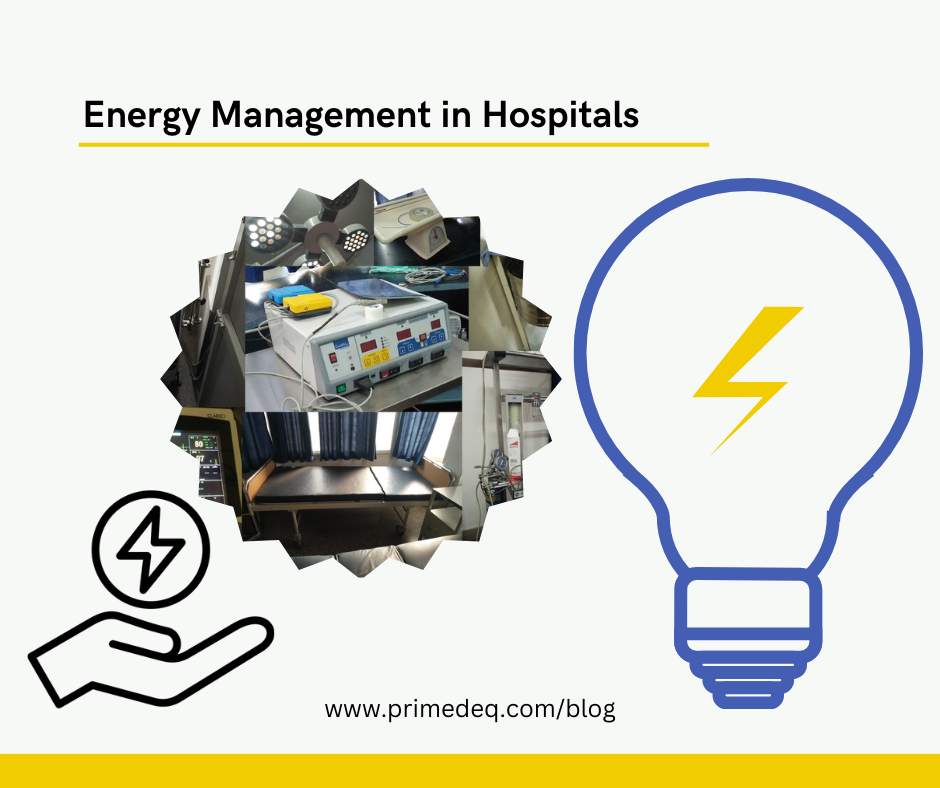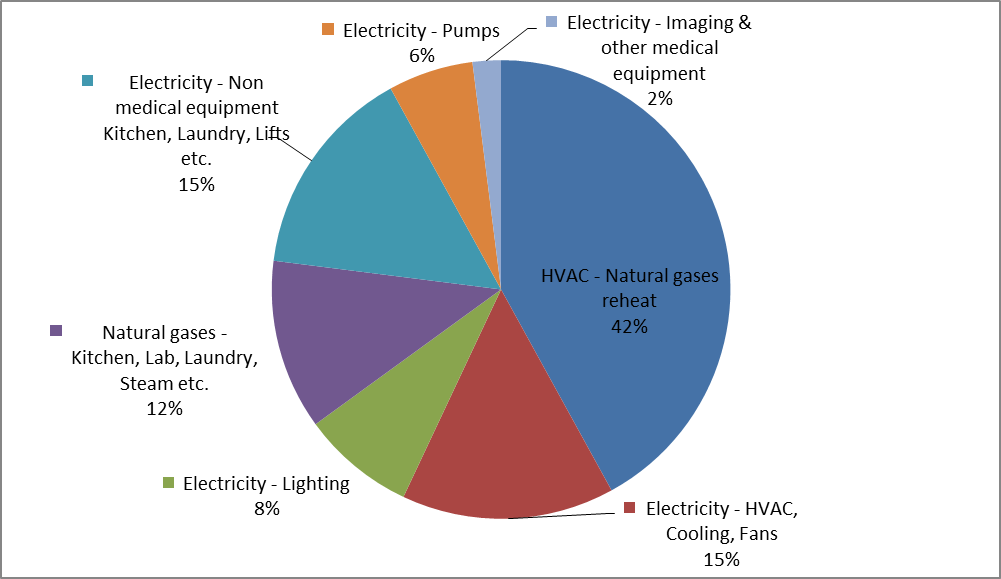
Steps towards saving energy in hospitals
Hospitals are massive energy consumers. Large hospitals leave their impact on our environment by using fossil fuels mainly in the following two ways – use of natural gases for various medical and non-medical purposes and electricity generated from fossil-fuels. Other uses could be diesel/petrol used in DG sets, vehicles etc. Energy costs could be anywhere around 2-3% of the hospital turnover. Therefore, any reduction in consumption could be a significant saving. Most importantly, sincere energy management is critical from the point of view of sustainable healthcare today. So, what are the ongoing initiatives in energy management in hospitals in India today?
Areas of focus for Sustainability in healthcare
NABH, Joint Commission International (JCIA) and SEBI have all set the ball rolling to ensure that large and accredited healthcare providers start taking initiatives to meet sustainable development goals. Large hospitals consume huge amount of energy/ electricity and generate tremendous amounts of waste, including hazardous waste, polluting the environment. The following areas are therefore focus for sustainability initiatives and regulatory thrust:
- Energy management – Reducing energy consumption (especially based on fossil fuel)
- Waste management – Recycle more, minimize waste going to landfill/ incineration.
- Air quality management – Reduce greenhouse gases emission and carbon footprint
- Water management – not release untreated water waste
As mentioned earlier, energy costs constitute nearly 2-3% of the turnover and hence any savings could help boost the bottom line. Leading hospitals in India have already taken steps towards all of the sustainability initiatives mentioned above, including energy management.
What are the key initiatives for energy management in hospitals?
How are modern hospitals using energy today?
Before jumping into energy management, let us look at what are the areas in which hospitals are consuming energy today.
As per various studies done – heating, cooling, air-pressure management, lighting, pumping fluids and gases take up maximum energy in hospitals. The other area is equipment operation. The following graph provides a rough break-up of energy utilization in a modern hospital.

Hospitals are very large, people and equipment intensive spaces. They need good HVAC systems to ensure a comfortable environment for the patients. They also require active air-pressure management due to good infection control practices and natural gases, heating, cooling, steam generation, refrigeration, waste management of different types for all types of operational objectives. Therefore they require a large amount of energy to meet all these varied requirements.
Main categories of energy usage in a hospital
From the above we can deduce that the following are the main categories of energy usage in hospitals:
- HVAC, fans & lighting: As can be seen from the above break-up of energy consumption, more than half the energy consumed in the hospitals go towards HVAC systems, so as to maintain comfortable temperatures, air pressure quality, as required at various places in the system. Lighting is needed all across. These are areas where energy is consumed 24/7, varying based on occupancy and time of the day.
- Medical equipment: Hospital operations depend on a wide range of medical equipment, including imaging systems, surgical equipment, diagnostic equipment, and critical care equipment. These devices may consume energy while in operation and also during idle times. Energy management in hospitals is incomplete without talking about energy efficient medical equipment. Read more on this.
- Pumping various gases and fluids, water heating, steam generation etc. : Hospitals use oxygen and other medical gases, steam, hot water for various purposes such as anesthetisation, surgeries, intensive patient care, cleaning, and sterilization.
- Refrigeration: Hospitals require refrigeration for storing vaccines, medications, and blood products in the laboratory and blood bank.
- Support systems: Other energy-consuming systems in hospitals may include elevators, dumb-waiters, Central Sterile Supply Department, laundry facilities, kitchen, computers and other support systems.
HVAC and lighting put together constitute 2/3rd of a typical hospital’s energy bill. Both these areas present ample opportunities for significant savings. The methods are not different from those applicable for other types of large buildings.
Naturally, this has been the first focus area for energy savings by most hospitals.
Energy management initiatives by leading healthcare providers in India
Hospitals are massive energy consumers due to their 24/7 operations and HVAC & Lighting systems, not to mentioned energy heavy equipment. So, what are the leading hospitals doing to reduce their energy consumption and thereby reducing the carbon footprint? Energy management in hospitals largely includes system design enhancements, investments in energy efficient equipment, and intelligent data-driven automation of entire hospital operations including HVAC, lighting and medical equipment.
From the ESG Reports and Business Responsibility and Sustainability Reports (BRSR) filed by top listed healthcare providers for the year 2023, the following initiatives seem to be most common:
Adopting renewable energy sources and reducing fossil fuel based energy
Many leading hospitals are transitioning to renewable energy sources, where possible, primarily solar energy but also wind and Hydro. Some have set themselves a target of 25% or more of renewable energy sources and some have already exceeded this.
Reducing energy consumption
As per the BRSR 2022-23 reported by leading hospitals, the ‘energy intensity’ figures ranged anywhere between 5-34 GJ/ (Turnover in Mn Rs). A couple of entities have also reported energy intensity figures per Occupied Bed Days. This ranged between 0.3-0.35 GJ per Occupied Bed Day, for those who reported. In other words average energy consumption in electricity terms per bed per day was about 90 units.
1 GJ is equal to about 278 Kwh or 278 units of electricity.
Interestingly, Narayana Health (NH) has also reported energy intensity metric per Sq.ft of built-up area (In other words Energy Performance Index or EPI) in the BRSR report for year ended Mar 2023. NH has reported energy intensity of 0.07 GJ/Sq.ft of builtup area (roughly 209 Kwh/sq.m) in the year ending Mar 2023, an improvement, compared to 0.09 GJ/Sq.ft (roughly 268 Kwh/sq.m) reported in the previous financial year.
A recent report by the Confederation of Indian Industry (CII) states that almost 60% of the hospitals and healthcare facilities do not meet the minimum criteria of the Energy Performance Index (EPI) which is 200 kWh/sq.m/year. Most Indian hospitals have the potential to conserve 42% of the energy consumption by implementing energy-efficient measures as per this report.
As per BRSR 2023, Energy intensity varied widely across key players. However, it must be mentioned that most of them had already implemented some measure or the other towards energy conservation. Many hospitals engaged Smart Joules, as consultant for energy savings. Their offering, JoulesPay guaranteed certain savings with pay-as-you-save scheme. Other initiatives included shift to LED bulbs and significant renewable energy sources. Some have gone for more energy efficient equipment/ Infrastructure.
What does energy management in hospitals entail?
Key energy efficiency measures undertaken by leading hospitals could include among other things, the following possible solutions:
- On-site renewable power generation initiatives, such as externally mounted solar panels.
- Continuous monitoring of the hospital building’s energy system. This can lead to 10 to 15% in the annual energy bills. Real-time monitoring systems to reducing the use of HVAC with occupancy linked utilization as well as upgrading, calibrating, balancing, tuning of all HVAC components to current performance standards.
- Replacing lighting with LED or other energy-saving light bulbs. A smart lighting system helps save 20-40% energy.
- Installing combined heat and power (CHP) systems.
- Last, but not the least – Upgrade hospital equipment for energy-efficient models.
As of today, may be only top 10 chains of hospitals have started sincere efforts towards energy management. Most other hospitals have a long way to go.
PrimedeQ is an e-Marketplace for buying, selling, renting, servicing and spares of medical equipment. We offer all types of used / refurbished medical equipment , including cathlab, ECG machine and other diagnostic equipment, endoscopes, OT equipment, Laparoscopic Equipment, Lab equipment, X-Ray, TMT, anesthesia machine, ultrasound machines etc including physiotherapy and rehabilitation equipment (New & Used). We offer repair services for all types of medical equipment.
Contact us for any medical equipment requirements on 7019759765.
https://in.linkedin.com/in/shanthi-mathur-ab07838
